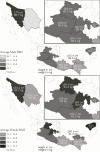The body as a mirror of inequality in México during the second half of the twentieth century
- PMID: 38865560
- PMCID: PMC11163961
- DOI: 10.1590/S0104-59702024000100018en
The body as a mirror of inequality in México during the second half of the twentieth century
Abstract
This paper examines how variations in the height and health of Mexicans during the second half of the twentieth century reflect the evolution of economic inequality, as its effects have repercussions on the health and nutritional conditions of the population. The average height of Mexican adults had a modest increase with respect to the possibilities of human plasticity. These anthropometric variations were the result of the incorporation of advances in science and technology leading to improved standards of living among the population. Body changes were impacted by dietary habits, urbanization, and government policies supporting food production and distribution.
Este trabajo examina cómo las variaciones en la estatura y la salud de los mexicanos durante la segunda mitad del siglo XX son un reflejo de la evolución de la desigualdad económica pues sus efectos repercuten en las condiciones de salud y alimentación de la población. La estatura promedio de adultos mexicanos tuvo un aumento modesto con respecto a las posibilidades de la plasticidad humana. Estas variaciones antropométricas fueron resultado de la incorporación de avances en ciencia y tecnología conducentes a mejorar los niveles de vida de la población. Los cambios corporales fueron impactados por hábitos alimenticios, de urbanización y políticas gubernamentales de apoyo a la producción y distribución de alimentos.
Conflict of interest statement
Conflict of interest
There were no conflicts of interest during the realization of this research.
Figures



Similar articles
-
The ups and downs of Mexican economic growth: the biological standard of living and inequality, 1870-1950.Econ Hum Biol. 2003 Jun;1(2):169-86. doi: 10.1016/S1570-677X(03)00039-X. Econ Hum Biol. 2003. PMID: 15463972
-
Towards an anthropometric history of latin America in the second half of the twentieth century.Econ Hum Biol. 2016 Dec;23:226-234. doi: 10.1016/j.ehb.2016.10.001. Epub 2016 Oct 7. Econ Hum Biol. 2016. PMID: 27756007
-
The gender gap in the biological living standard in Spain. A study based on the heights of an elite migration to Mexico, 1840-1930.Econ Hum Biol. 2021 May;41:100993. doi: 10.1016/j.ehb.2021.100993. Epub 2021 Feb 26. Econ Hum Biol. 2021. PMID: 33676154
-
Where's the capital? A geographical essay.Br J Sociol. 2014 Dec;65(4):721-35. doi: 10.1111/1468-4446.12112. Br J Sociol. 2014. PMID: 25516349 Review.
-
Inequality in the long run.Science. 2014 May 23;344(6186):838-43. doi: 10.1126/science.1251936. Science. 2014. PMID: 24855258 Review.
References
-
- AVILA-CURIEL Abelardo, et al. Vista de la desnutrición infantil en el medio rural mexicano: Análisis de las encuestas nacionales de alimentación. Salud Pública de México. 1993;35(6):658–666. - PubMed
-
- BASSOLS BATALLA Ángel. La división económica regional de México. Investigación Económica. 1964;24(95):387–413.
-
- BOGIN Barry. The growth of humanity. New York: Wiley-Liss; 2001.
-
- BOGIN Barry, LOUCKY James. Plasticity, political economy, and physical growth status of Guatemala Maya children living in the United States. American Journal of Physical Anthropology. 1997;102(1):17–32. 10.1002/(SICI)1096-8644(199701)102:1<17::AID-AJPA3>3.0.CO;2-A - DOI - PubMed
Publication types
MeSH terms
LinkOut - more resources
Full Text Sources

